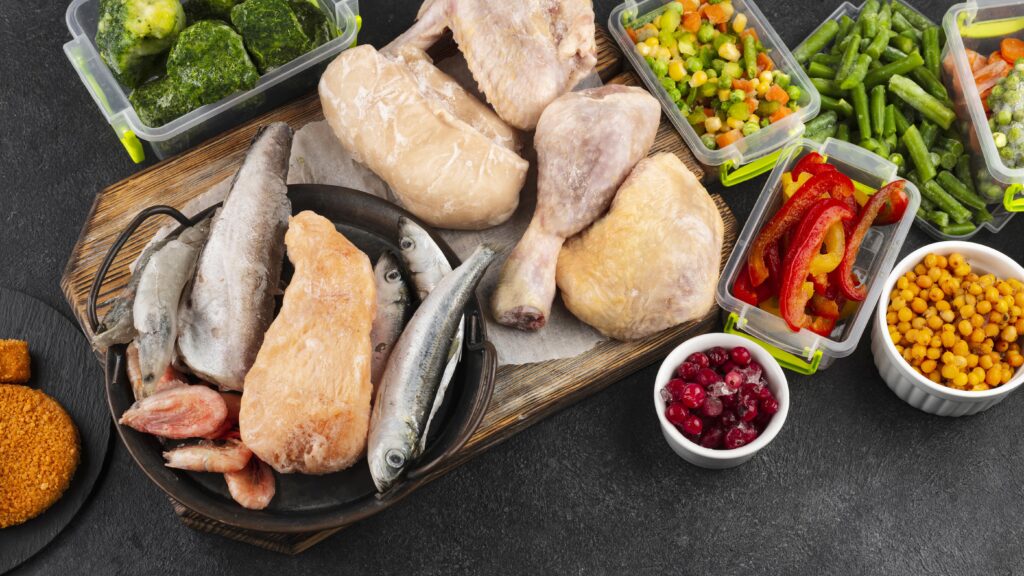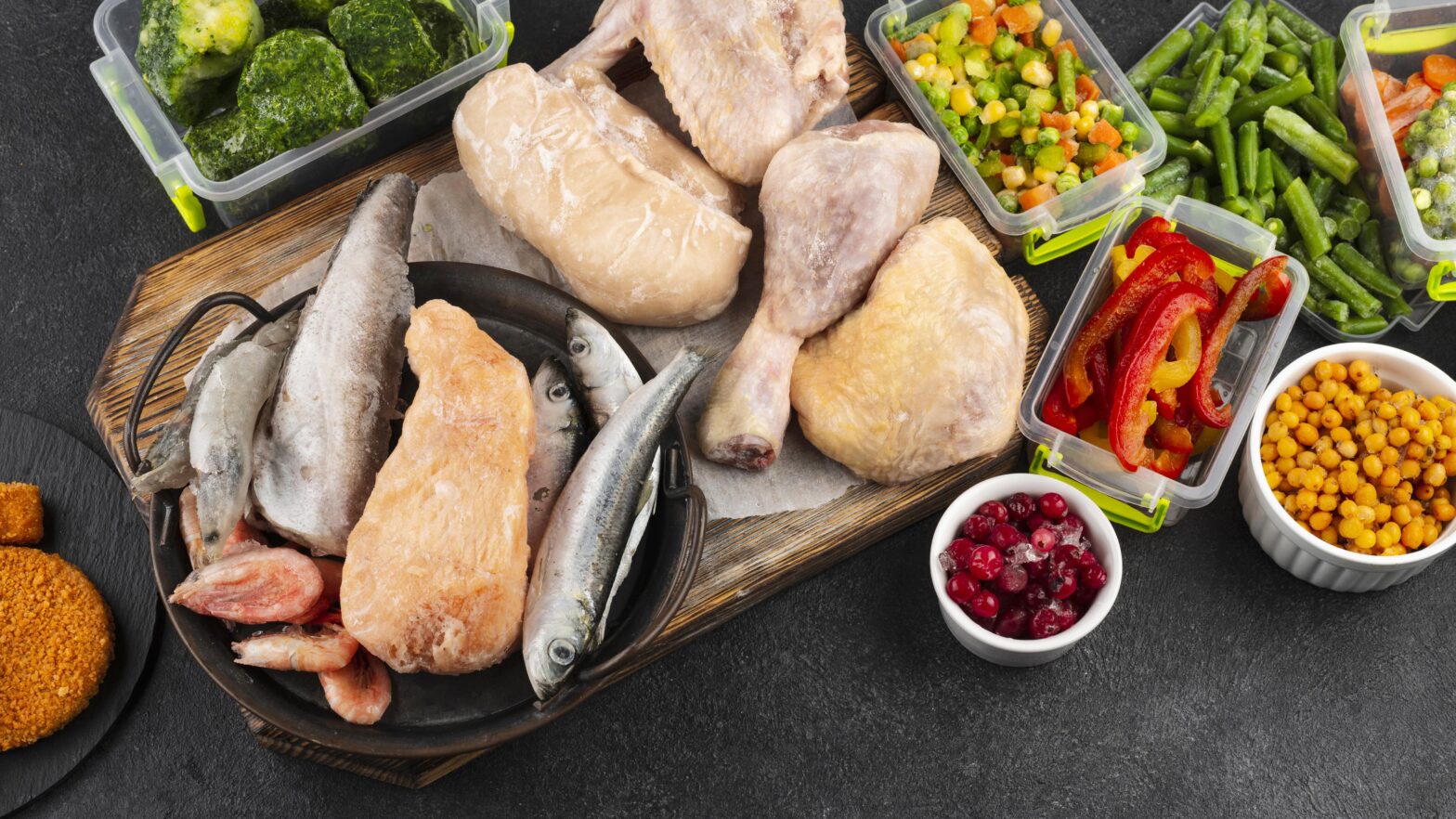
What are frozen foods?
Frozen foods refer to any type of food product that has been preserved through freezing. Freezing is a process that involves lowering the temperature of food to below its freezing point, typically to around -18°C (0°F) or lower. This process helps to inhibit the growth of microorganisms, slows down enzymatic activity, and preserves the quality and freshness of the food.
How are Frozen Foods beneficial?
Convenience and time-saving
Frozen foods provide convenience by eliminating the time-consuming tasks of food preparation, such as chopping and peeling. Whether it's a busy weeknight or a spontaneous gathering, having pre-prepared frozen meals or ingredients on hand allows for quick and hassle-free cooking without sacrificing taste or quality.
Longer shelf life and reduced food waste
Frozen foods have a longer shelf life compared to fresh produce, minimizing food spoilage and waste. Freezing suspends bacterial growth and enzymatic activity, preserving the taste, texture, and nutritional value of the food. This is advantageous for households, enabling better inventory management and reducing food waste by using portions as needed while keeping the rest preserved for later use.
Nutritional value and quality preservation
Contrary to popular belief, frozen foods can retain their nutritional value and quality. The flash-freezing process preserves essential vitamins and minerals, locking in the nutrients until consumption. Frozen fruits and vegetables, picked at their peak ripeness, can be just as, if not more, nutritious than fresh produce that may have spent longer in transit or on shelves.
Cost-effectiveness and budget-friendly options
Frozen foods can be an economical choice for individuals and families on a budget. They often offer cost-effective alternatives to expensive out-of-season produce. Additionally, buying frozen ingredients or meals in bulk can lead to savings, as larger quantities are usually available at a lower unit price. Moreover, frozen foods allow for better portion control, as you can use only what you need and store the rest for later, minimizing waste and maximizing value for your money.
What are the types in Frozen Foods:
Fruits and vegetables
Frozen fruits and vegetables are popular options that offer convenience and year-round availability. They are often harvested at their peak ripeness and quickly frozen to retain their nutritional value and flavor. Frozen fruits are commonly used in smoothies, desserts, and baking, while frozen vegetables are versatile ingredients for soups, stir-fries, and side dishes. These frozen options provide a convenient way to incorporate fruits and vegetables into your diet, especially when fresh options are not readily available or out of season.
Seafood and meats
Frozen seafood and meats are widely available and offer a convenient way to incorporate protein-rich foods into meals. Freezing seafood and meats helps to maintain their freshness, texture, and flavor. From shrimp and fish fillets to chicken breasts and beef cuts, the variety of frozen options is extensive. They can be used as the main ingredient in various dishes, such as stir-fries, stews, and grills. Additionally, frozen seafood and meats often come individually portioned, allowing for easy meal planning and reducing food waste.
Prepared meals and entrees
Frozen-prepared meals and entrees have gained popularity due to their convenience and wide variety of options. These meals are often pre-cooked and frozen, requiring minimal preparation or cooking time. They range from classic dishes like lasagna and macaroni and cheese to international cuisines like curry or stir-fried noodles. Frozen prepared meals provide a quick and hassle-free solution for individuals with busy schedules or limited cooking skills, offering a balance between convenience and a satisfying meal.
Desserts and baked goods
Frozen desserts and baked goods offer a sweet treat that can be enjoyed at any time. From ice creams and sorbets to cakes and pastries, the frozen dessert section provides a wide range of indulgent options. Many of these frozen treats are made with high-quality ingredients and come in various flavors and sizes. Similarly, frozen baked goods such as cookies, pies, and bread are available for quick enjoyment or for thawing and heating in the oven. These frozen options allow for a delightful and effortless way to satisfy your sweet tooth.
Snacks and appetizers
Frozen snacks and appetizers are popular for entertaining guests or as convenient bite-sized options for individual snacking. These options include items like frozen pizza bites, spring rolls, chicken wings, mozzarella sticks, and mini quiches. The freezer section often offers a wide selection of these convenient and tasty treats. They can be quickly heated in the oven or microwave, making them ideal for impromptu gatherings or as a quick snack option during movie nights or parties.
Frozen Foods and Sustainability
Reduced food waste and environmental impact
Frozen foods play a role in reducing food waste and minimizing the environmental impact of the food industry. By freezing food at its peak freshness, it can be preserved for longer periods, reducing the likelihood of spoilage and waste. This helps to minimize the amount of food that ends up in landfills, which contributes to greenhouse gas emissions. Additionally, freezing technology allows for the utilization of surplus produce, which may otherwise go to waste due to market fluctuations or cosmetic imperfections.
Supporting local and seasonal produce
Choosing frozen foods that are sourced from local and seasonal produce can have a positive impact on sustainability. Local and seasonal sourcing helps to reduce the carbon footprint associated with transportation and storage. By opting for frozen fruits and vegetables that are grown and harvested locally, consumers can support regional agriculture, promote biodiversity, and contribute to the resilience of local food systems.
Packaging and recycling considerations
While the convenience of frozen foods is undeniable, it's important to consider the packaging and its impact on the environment. Some frozen food packaging materials may contribute to waste and pollution. However, many frozen food brands are now making efforts to improve their packaging sustainability. Look for options with packaging that is made from recycled or recyclable materials. Additionally, consider purchasing in bulk or choosing larger package sizes to reduce the overall amount of packaging waste generated.
Making informed choices for sustainable brands
To support sustainability in the frozen food industry, consumers can make informed choices by selecting brands that prioritize environmentally-friendly practices. Look for certifications or labels that indicate sustainable farming or sourcing methods, such as organic, fair-trade, or sustainably-caught seafood. Research brands that prioritize ethical and sustainable production, including responsible sourcing of ingredients and commitment to reducing their environmental footprint. By supporting these brands, consumers can contribute to a more sustainable frozen food industry.
In conclusion,
frozen foods have evolved to offer convenience, nutritional value, and sustainability. They save time, reduce food waste, and provide cost-effective options. Contrary to misconceptions, frozen foods retain their quality and taste when properly selected and cooked. They encompass a wide range of choices, from fruits and vegetables to meats, desserts, and snacks. By making informed choices and supporting sustainable brands, consumers can contribute to a more sustainable food system. Embracing the convenience and benefits of frozen foods allows individuals to enjoy delicious meals while promoting a healthier and more sustainable lifestyle.







